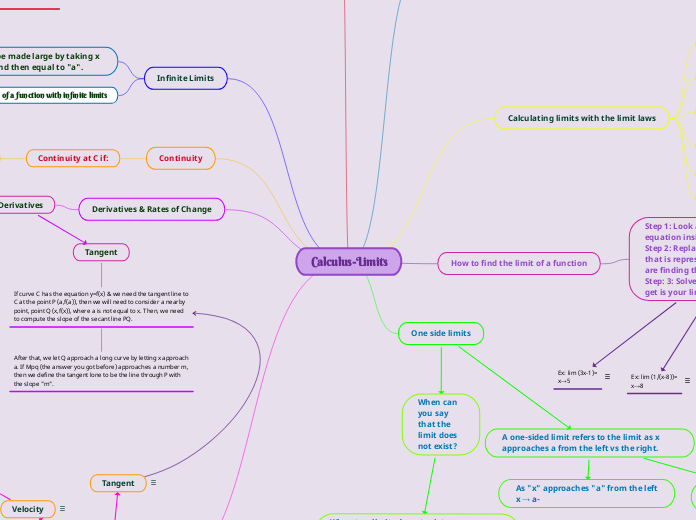Calculus-Limits
Limits at infinity
Formal notation of a limit at infinity
lim f(x)= L
x→∞
Ex:
lim (1/x)=0
x→∞
Ex:
lim √(16x^(2)-8)/(2x-5)=2
x→∞
Infinite Limits
Values of f(x) can be made large by taking x very close to "a" and then equal to "a".
Notation of a function with infinite limits
lim f(x) = ∞
x->a
Formal notation of a function limit
lim f(x) = L
x→a
or
lim f(x)=L; x->a
"L" - limit
"a" - as "x" approaches (blank)
Calculating limits with the limit laws
The Sum Rule
lim (f(x)+g(x)); x→a = lim f(x); x→a + lim g(x); x→a = L+M
The Difference Rule
lim (f(x)−g(x)); x→a = lim f(x); x→a − lim g(x); x→a = L−M
The product Rule
lim (f(x)·g(x)); x→a = lim f(x); x→a · lim g(x); x→a = L·M
The Quotient Rule
lim f(x)g(x); x→a = lim f(x); x→a lim g(x); x→a = LM for M≠0
The Constant Rule
lim [cf(x)]; x→a = c·lim f(x); x→a = cL
The Power Rule
lim [cf(x)]; x→a = c·lim f(x); x→a = cL
How to find the limit of a function
Step 1: Look at the function and the equation inside of it.
Step 2: Replace the "x's" with the number that is representative to "a", since we are are finding the limit as x approaches "a".
Step: 3: Solve, then whatever answer you get is your limit.
Ex: lim (3x-1)=
x→5
Ex: lim (1/(x-8))=
x→8
Ex: lim (x-1)/((x^2)-1)
One side limits
When can you say that the limit does not exist?
When two limits do not exist:
When the limit you get when x is approaching a to the left and x is approaching a to the right do not match, the limit when x is approaching a (from both sides) does not exist. DNE
A one-sided limit refers to the limit as x approaches a from the left vs the right.
As "x" approaches "a" from the left
x → a-
As "x" approaches "a" from the right
x → a+
Continuity
Continuity at C if:
f(a) is defined
lim f(x); x->a = f(a)
f(x) has a limit as x approaches a
In other words:
A function is continuous if a small change in x produces a small change in f(x)
Derivatives & Rates of Change
Derivatives
Derivative - The type of limit that occurs in both tangent lines and velocities.
Tangent
If curve C has the equation y=f(x) & we need the tangent line to C at the point P (a,f(a)), then we will need to consider a nearby point, point Q (x,f(x)), where a is not equal to x. Then, we need to compute the slope of the secant line PQ.
After that, we let Q approach a long curve by letting x approach a. If Mpq (the answer you got before) approaches a number m, then we define the tangent lone to be the line through P with the slope "m".
Velocity
Tangent & Velocity
Tangent
Velocity
Average velocity
The average velocity is the distance travelled over a certain interval of time.
Instantaneous velocity
The instantaneous velocity is the velocity at a specific time.
